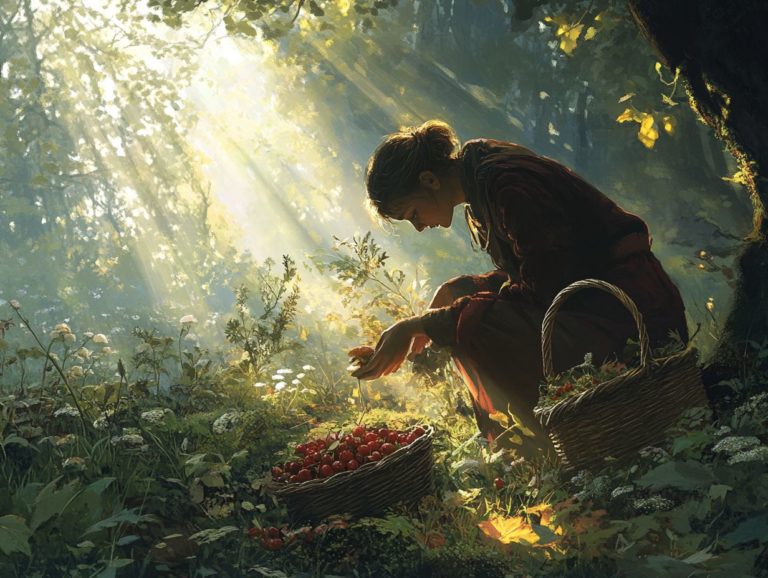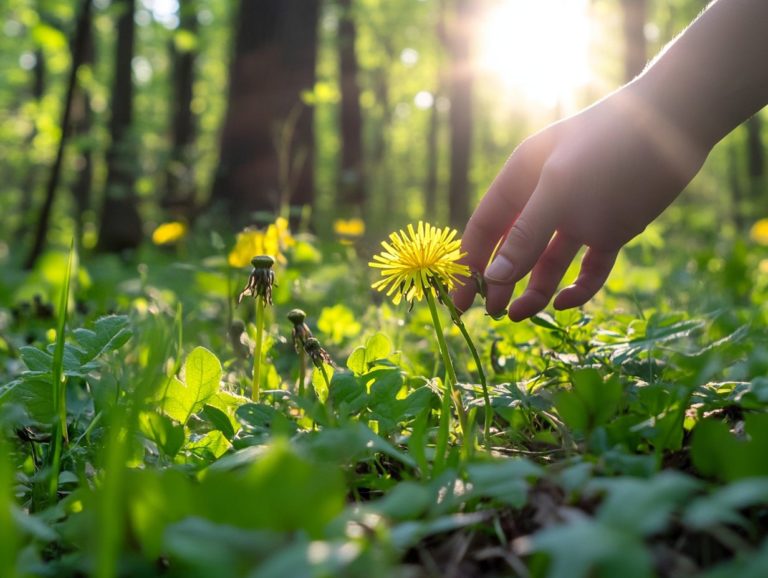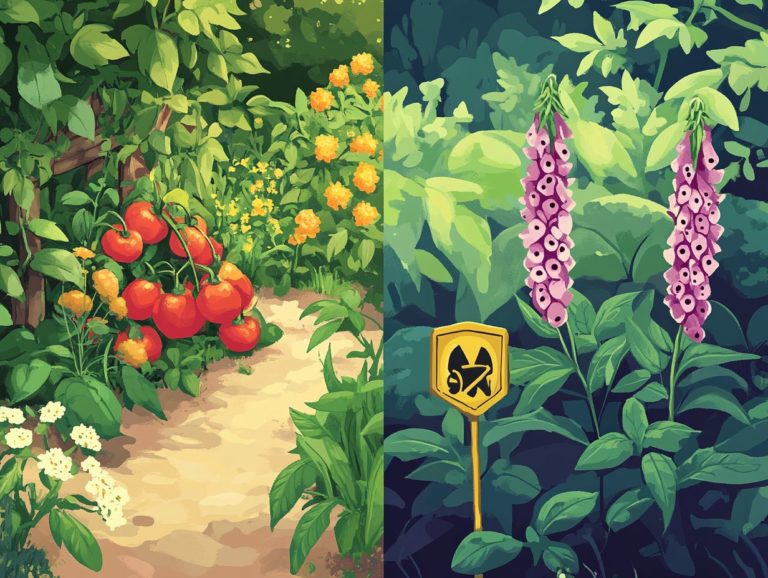10 Common Edible Plants in Europe
Exploring the realm of wild edible plants offers both excitement and unparalleled rewards. Imagine uncovering vibrant dandelions and the sweet allure of wild strawberries Europe is a veritable treasure trove of natural flavors waiting for you to discover.
This article introduces you to ten common edible plants you can find in the wild, complete with essential tips on how to identify, harvest, and prepare them. You’ll also learn about their health benefits, how to incorporate them into your diet sustainably, and the necessary precautions to keep in mind.
Whether you re a seasoned forager with a wealth of experience or a curious beginner eager to explore, there s something here for everyone to savor.
Contents
- Key Takeaways:
- 1. Dandelion
- 2. Nettles
- 3. Wild Garlic
- 4. Elderflower
- 5. Wild Strawberries
- 6. Rosehips
- 7. Sorrel
- 8. Wild Asparagus
- 9. Blackberries
- 10. Hazelnuts
- How to Properly Identify and Harvest Edible Plants
- What Are the Nutritional Benefits of Eating Wild Edible Plants?
- What Are the Different Ways to Prepare and Cook Edible Plants?
- What Are the Possible Risks and Precautions When Eating Wild Edible Plants?
- What Are the Common Mistakes to Avoid When Foraging for Edible Plants?
- How Can Edible Plants Be Incorporated into a Sustainable Diet?
- Frequently Asked Questions
- What are the 10 common edible plants in Europe, including forageable, wild, and naturalized species?
- Can all parts of these plants, such as edible parts like leaves, flowers, and berries, be eaten?
- Are these plants safe to eat, provided they are correctly identified following safety guidelines and U.S. Army guidelines for foraging?
- What are the health benefits of these edible plants, including wild garlic and ground ivy, which are rich in vitamins, minerals, and antioxidants?
- How can I incorporate these plants into my diet through various cooking methods such as making herbal tea or wild soup?
- Are there any precautions I should take when foraging for these plants, including identifying toxic plants and avoiding food poisoning or allergic reactions?
Key Takeaways:
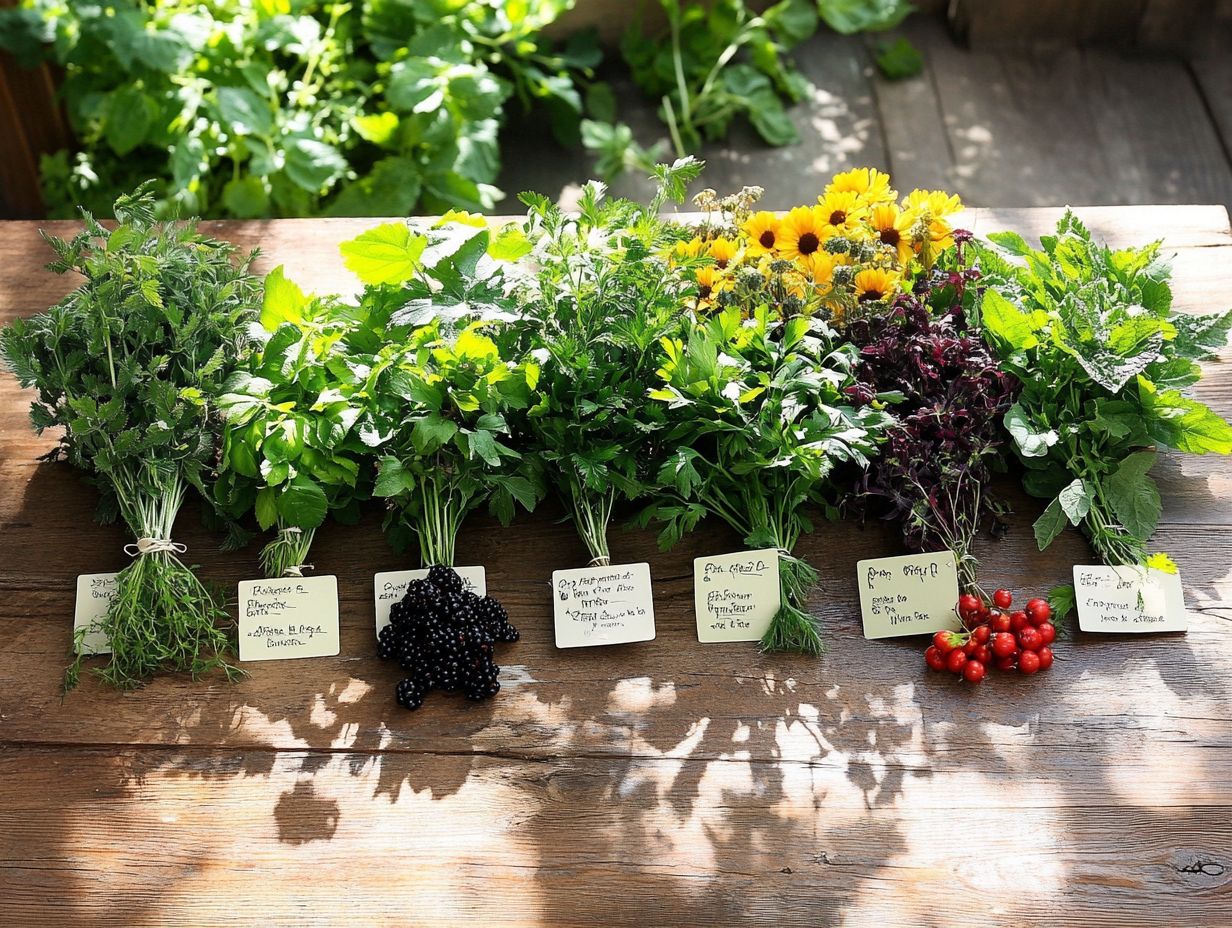
- Dandelions, nettles, and wild garlic are easily found and nutritious edible plants in Europe.
- Harvest and prepare edible plants properly to enjoy their benefits and avoid potential risks.
- Eating edible plants supports sustainable diets and connects us with nature.
1. Dandelion
Dandelion, scientifically known as Taraxacum agg., is a remarkable wild plant found across North America and Europe. Often spotted in gardens and meadows, this vibrant plant is known for its cooking uses and impressive health benefits. The young leaves are packed with vitamins and minerals, while the bright flower petals add a unique flair to your dishes.
Harvest young leaves in spring for salads. Their slight bitterness pairs well with creamy dressings. The sunny yellow flowers bloom throughout the warmer months and can be transformed into dandelion wine or candied for a delightful garnish. Feeling adventurous? Roast the roots for a delicious caffeine-free coffee alternative made from roasted dandelion roots that tastes similar to coffee.
Identifying dandelions is a breeze; just look for their jagged leaves, hollow stems, and distinctive yellow blooms.
When foraging, aim for areas free from pesticides, taking care to steer clear of plants near roadsides or polluted sites. The best time to forage for dandelions is from spring to early summer. Don t miss out on these nutritious weeds!
2. Nettles
Nettles, or Urtica dioica, may have earned a bad reputation for their sting, but don t let that deter you. These wild greens are actually a treasure trove of nutrition and have been embraced in various culinary and medicinal practices across cultures.
Look for nettles in lush, dense patches along roadsides or in damp woodlands. Identify them by their serrated leaves and the tiny stinging hairs that release an irritant upon contact. If you decide to forage for them, be sure to don some protective gloves.
Once you ve gathered your bounty, you can easily neutralize the sting by cooking them boiling, saut ing, or steaming works wonders. Nettles add a delightful touch to soups, pesto, and even pasta dishes, making them a versatile ingredient in your kitchen.
Beyond their culinary charm, nettles boast noteworthy medicinal benefits. They re renowned for alleviating allergy symptoms and reducing inflammation, making them a go-to for anyone seeking natural remedies for issues like hay fever or joint pain. Embrace the world of nettles; they’re more than just a prickly plant!
Start foraging and experimenting with these plants, and enjoy the excitement of exploring nature’s bounty!
3. Wild Garlic
Wild garlic, scientifically known as Allium ursinum, is a delightful wild edible plant that you can find thriving in wooded areas. Its distinctive aroma and flavor make it a favorite among foragers.
This plant is perfect for adding a touch of gourmet flair to everything from salads to pesto. It is a perennial herb, meaning it lives for more than two years, and boasts broad, lanceolate leaves that emerge from the earth, typically making their grand entrance in early spring.
Its striking white flowers, resembling clusters of stars, not only enhance its visual charm but also make it easily recognizable. If you re keen on foraging, it s essential to distinguish wild garlic from similar-looking plants like lily of the valley, which can be toxic.
A simple yet effective method for confirming your find is to crush a leaf and take a whiff; if you catch a potent garlic scent, you ve found a great find in cooking.
Nutritionally, wild garlic is a powerhouse, loaded with vitamins A and C that support immune health while imparting that beloved garlic flavor without the bite of its cultivated cousins. Remember to forage responsibly harvest in moderation to protect local ecosystems and ensure that this delightful plant continues to thrive.
4. Elderflower
Elderflower, especially from the Sambucus tree species, is a true gem, celebrated for its delicate, fragrant blossoms that bloom during the warmer months. These blossoms add a delightful touch to your culinary creations and elevate herbal teas, thanks to their subtle floral flavor and potential health benefits.
The prime time for foraging elderflower is late spring to early summer, usually from May to June. This is when the blossoms are in their full glory, wafting a sweet aroma that s hard to resist.
When identifying the flowers, keep an eye out for clusters of tiny white blooms with a creamy look, typically sprouting from a shrub that can grow several meters tall. These lovely blossoms can easily be turned into delightful syrups, refreshing drinks like elderflower cordial, or even used to elevate your desserts.
Elderflower offers more than just culinary charm; it has a rich history in folk medicine for its potential anti-inflammatory and immune-boosting properties. Of course, it s wise to proceed with caution, as some people might have allergic reactions.
Starting with small amounts will help you test your tolerance before fully embracing this enchanting floral addition in your recipes.
5. Wild Strawberries
Wild strawberries are small powerhouses of flavor, a delightful wild fruit waiting to be discovered in woods and fields. They not only boast an impressive nutritional profile but also shine in various culinary applications, from jams to desserts and salads.
These tiny gems pack a powerful punch of flavor! They tend to be smaller than their cultivated cousins, yet they offer a more intense sweetness and captivating aroma.
To identify wild strawberries, look for their distinctive three-leaf clusters and delicate white blossoms that eventually yield bright red berries. When it comes time to harvest, do so with care, ensuring you pick only the ripe ones, typically ready between late spring and early summer.
Not only are these berries a fantastic source of vitamin C and antioxidants, but they also elevate your breakfast smoothies and add a pop of color to salads. They can simply be enjoyed fresh as a versatile addition that enhances any meal.
6. Rosehips
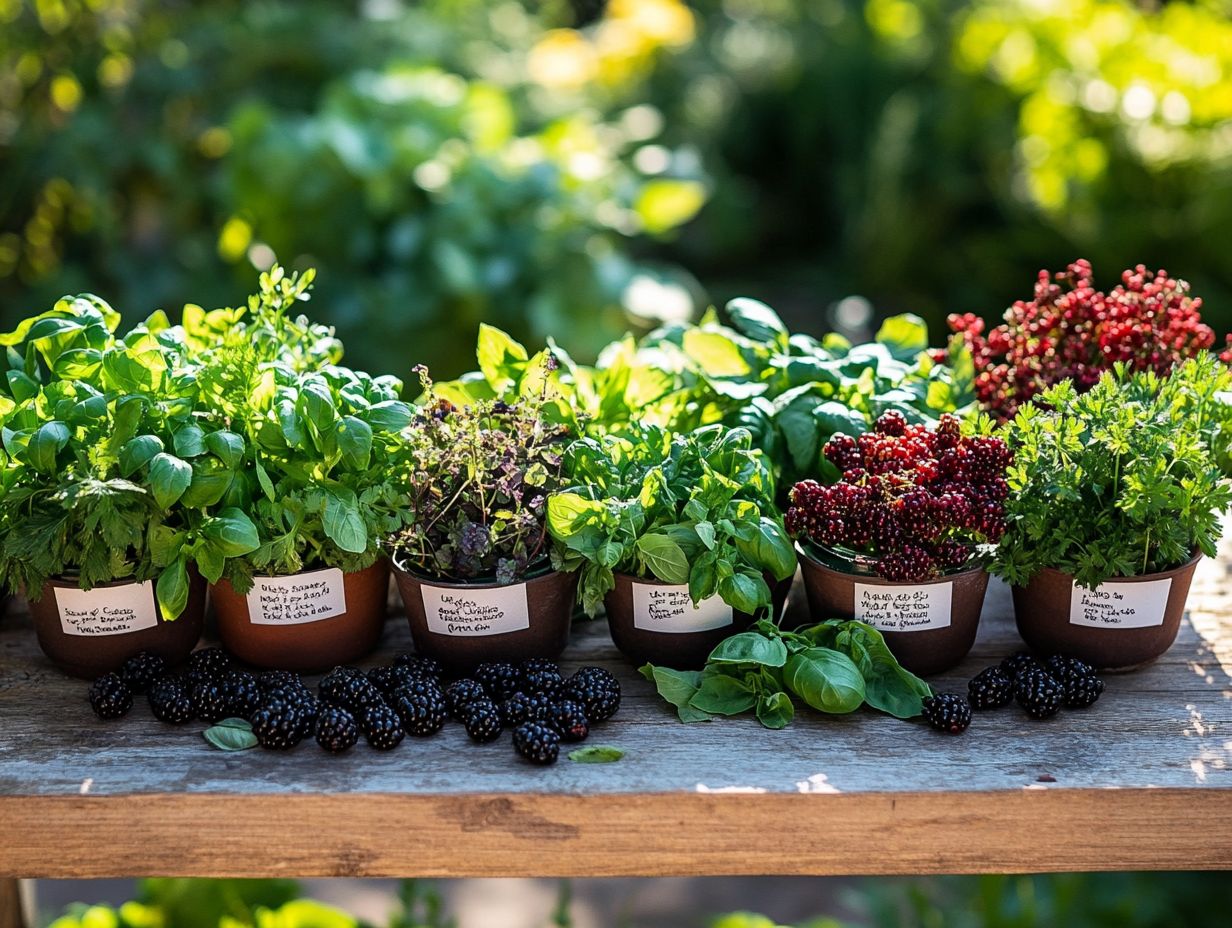
Rosehips, the often-overlooked fruit of the rose plant, are a treasure trove of nutrients and vitamins, waiting to be foraged in the late summer to early autumn. They can elevate your culinary creations and herbal remedies to new heights.
Among the many rose varieties that produce edible rosehips, the dog rose (Rosa canina) and the sweetbriar (Rosa rubiginosa) stand out as exceptional choices. Identifying these plants is a breeze; you’ll typically find them adorned with five-petaled pink or white flowers, followed by round, vibrant red or orange fruits.
Once you’ve harvested these delightful rosehips, you can transform them into soothing teas, homemade jams, and delicious syrups, all thanks to their impressive vitamin C content that bolsters your immune system.
Just a word of caution: the seeds nestled within the hips contain small amounts of substances that can be harmful in large amounts, so it s wise to strain them out or prepare them properly to ensure safety before indulging.
7. Sorrel
Sorrel is a vibrant wild green that you ll quickly come to love for its tangy flavor. It has distinct sour notes and is a favorite in salads, soups, and sauces. You can easily recognize it by its arrow-shaped leaves and unique taste profile.
Typically found in moist, temperate regions, you might find sorrel growing in your garden or foraged from the wild. You might discover sorrel growing in your garden or foraged from the wild. When you incorporate sorrel into your dishes, its fresh, zesty flavor pairs beautifully with proteins like fish and chicken, elevating your meals to remarkable new heights.
Preparation is a breeze; you can saut the leaves, blend them into sauces, or toss them fresh into salads for that invigorating zest. Nutritionally, sorrel is a powerhouse, packed with vitamin C, iron, and antioxidants. It makes a fantastic addition to a healthy diet.
Be careful if you re sensitive to oxalic acid (a compound found in some plants that can affect certain people).
8. Wild Asparagus
Wild asparagus is a coveted seasonal delight that flourishes in diverse environments. You ll appreciate its tender young shoots, which can be harvested in spring and added to a variety of dishes, from crisp salads to savory stir-fries.
This exquisite vegetable typically thrives in sandy or loamy soils, often favoring sunny spots like roadsides, fields, and uncultivated agricultural land. Identifying wild asparagus is easy; the young shoots present themselves as vibrant green spears, standing tall at about 6 to 12 inches.
The tips are tight and pointed, resembling delicate fern foliage as they mature. When prepared, wild asparagus offers a subtle nutty flavor that elevates any dish. It s fantastic in pasta, enriching soups, or simply grilled with a drizzle of olive oil and a sprinkle of sea salt to enhance its natural sweetness while preserving essential nutrients.
9. Blackberries
Blackberries are sweet, juicy wild berries that flourish in hedgerows and wooded areas throughout the summer months. They offer essential nutrients and delightful flavor, making them perfect for jams, desserts, or just enjoying fresh.
To spot these delectable berries, keep an eye out for thorny, arching canes adorned with green, serrated leaves and clusters of small, white flowers in spring. These flowers transform into dark, plump fruit by mid-summer. Harvest these juicy treasures quickly, as they are only ripe from late June to early August!
Beyond their irresistible taste, blackberries are packed with antioxidants and essential vitamins like C and K. They make a nutritious addition to your diet. However, you should exercise caution regarding potential look-alikes and any pesticides in areas near agriculture.
Always ensure that you re harvesting berries from clean environments to safely enjoy their myriad benefits.
10. Hazelnuts
Hazelnuts, the delightful edible seeds from the Corylus avellana tree, are a nutritious and versatile wild food you can forage in forests and hedgerows. Packed with healthy fats, proteins, and essential vitamins, they are a true treasure of nature.
To spot these trees, look for their distinctive oval-shaped leaves adorned with serrated edges and unique catkins that emerge in early spring. You’ll want to time your harvest for late summer to early autumn, when the nuts have gracefully fallen to the ground, signaling they re ready for picking.
Culinary enthusiasts often elevate their dishes with hazelnuts, using them to add depth to baked goods and desserts or infusing savory meals with a delightful nutty flavor. It s not just about taste; these nuts are also nutritional powerhouses, boasting high levels of antioxidants, fiber, and heart-healthy omega-3 fats.
While indulging in hazelnuts can be a treat, moderation is key. They are calorie-dense and may cause allergic reactions in some individuals. Always exercise caution and consult a medical professional if you have any concerns about allergies.
How to Properly Identify and Harvest Edible Plants
Identifying and harvesting edible plants demands careful attention to detail. Understanding plant characteristics empowers you to enjoy wild foods while avoiding toxic plants.
Master this art by immersing yourself in key features like leaf shape, flower color, and growth patterns. Avoid pitfalls such as relying on a single characteristic or declaring a plant edible based only on superficial resemblances.
Using reliable field guides and apps enhances your identification accuracy. Remember, safety is paramount; always test new plants in small quantities to watch for allergic reactions.
What Are the Nutritional Benefits of Eating Wild Edible Plants?
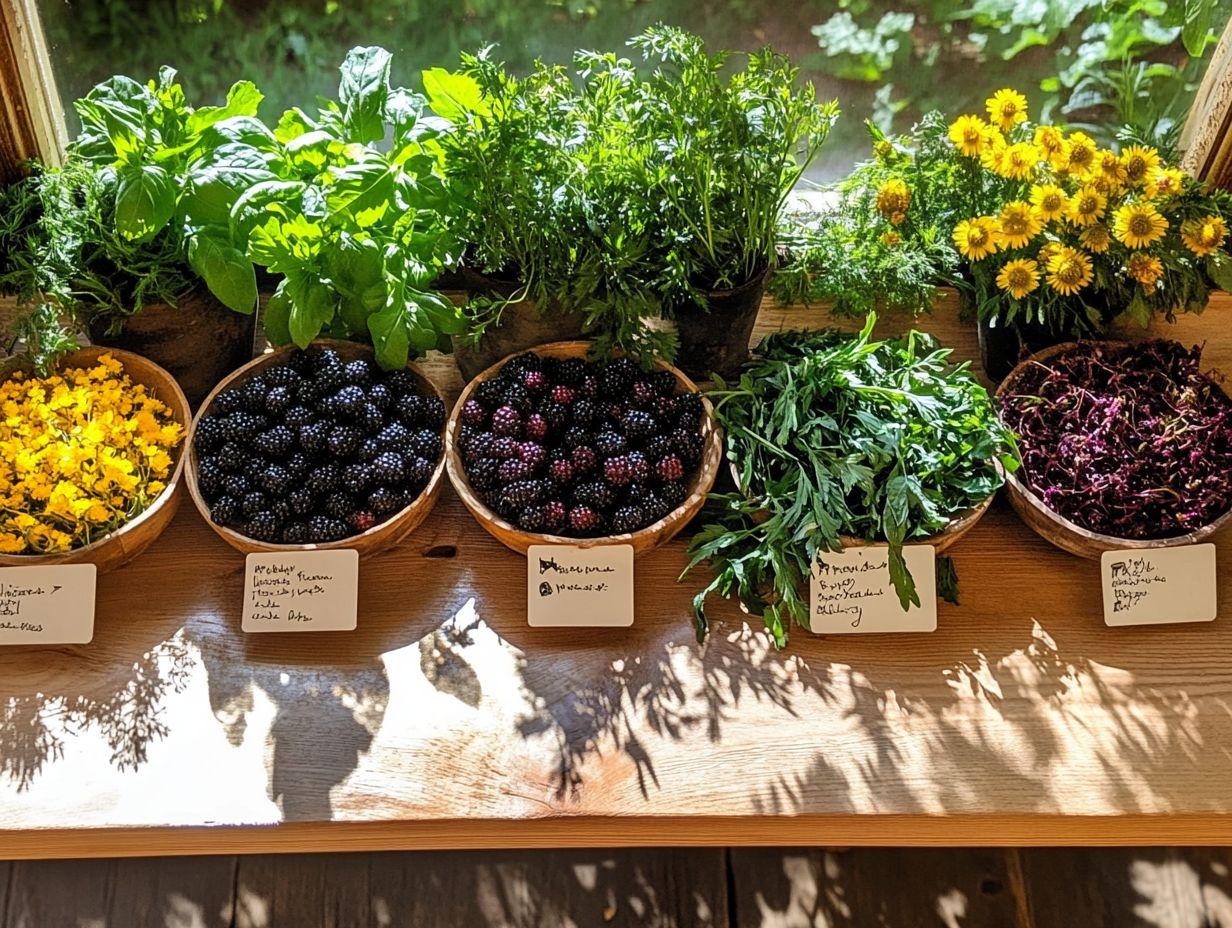
Wild edible plants are a sustainable food source that offers incredible nutritional benefits. For those interested in cultivating your own, consider exploring 10 edible plants to cultivate at home. They are packed with vitamins, minerals, and antioxidants that contribute to your health.
These natural treasures often outshine cultivated counterparts in nutrient density. For example, wild greens like dandelion and purslane have more calcium and omega-3 fatty acids than garden lettuce, making them great dietary choices.
Plants like stinging nettle provide substantial amounts of iron and vitamin C essential for your body. In survival situations, these wild edibles can enhance your nutritional intake while ensuring access to fresh food sources.
This is vital for preventing deficiency-related ailments, especially in challenging environments.
What Are the Different Ways to Prepare and Cook Edible Plants?
There are many ways to prepare and cook wild edible plants. Each method enhances their flavors while preserving their nutritional value.
Try the quick method of saut ing wild greens in olive oil. This brings out a rich, savory flavor and softens the texture, creating a satisfying dish.
Alternatively, boiling roots like dandelions tenderizes them while keeping their nutrients intact. The options are plentiful!
Drying herbs such as nettles allows you to create flavorful teas or seasoning blends. For a simple dish, try tossing saut ed wild garlic mustard leaves with a hint of lemon and sea salt for an enhanced dining experience.
What Are the Possible Risks and Precautions When Eating Wild Edible Plants?
While wild edible plants add nutrition to your diet, it’s important to acknowledge potential risks, like food poisoning and allergic reactions. Misidentifying toxic plants is another serious concern, which is why knowing the top 10 common edible weeds is essential.
Thorough research and proper identification are crucial before indulging in foraged delights. Familiarize yourself with the features that set safe species apart from harmful ones.
Understanding the environment where these plants grow is vital. Contaminated soil or water can lead to harmful substances being absorbed.
To minimize risks, consider foraging with an expert initially and always refer to reliable guides. Testing small amounts of a new plant can help prevent severe allergic reactions.
What Are the Common Mistakes to Avoid When Foraging for Edible Plants?
Foraging for edible plants can be a delightful adventure. However, it demands a blend of knowledge and caution to steer clear of common pitfalls that might lead to consuming toxic varieties or overlooking safe options, such as the 10 edible plants with medicinal properties.
Many novice foragers often misidentify species, confusing poisonous plants with their edible look-alikes. This can have serious consequences. It s easy to overlook essential safety guidelines, such as verifying the habitat in which a plant grows and recognizing seasonal changes that impact edibility. To navigate this landscape successfully, it s vital to invest time in understanding common look-alikes and to leverage reliable resources, such as field guides or mobile apps.
Consider joining local foraging groups. They can provide invaluable insights and hands-on experience that will sharpen your skills, transforming your foraging journey into a safe and rewarding pursuit.
How Can Edible Plants Be Incorporated into a Sustainable Diet?
Incorporating wild edible plants into your sustainable diet not only supports environmental health but also enriches your meals with a delightful array of flavors and nutrients. Discovering 10 unique edible plants around the world can create a deeper connection to the local ecosystem.
By venturing into nearby parks, forests, or even your own backyard, you can uncover a treasure trove of wild herbs, greens, and flowers that elevate everyday dishes. For instance, imagine tossing dandelion greens into your salad; they add a zesty peppery flavor and are packed with vitamins. To enhance your foraging experience, it’s helpful to be familiar with the top 10 wild plants everyone should recognize. Or picture foraged mushrooms transforming a simple pasta dish into a delicious meal.
Sourcing your ingredients locally through foraging reduces the carbon footprint linked to food transportation. This aligns perfectly with a more sustainable lifestyle. Traditional recipes, like nettle soup or wild garlic pesto, can be effortlessly adapted to modern palates, offering both flavor and an eco-conscious choice for those who care about what they eat.
Frequently Asked Questions
What are the 10 common edible plants in Europe, including forageable, wild, and naturalized species?

The 10 edible plants found in urban areas include nettle, dandelion, wild garlic, elderberry, blackberry, rosehip, hawthorn, sorrel, chickweed, and burdock.
Can all parts of these plants, such as edible parts like leaves, flowers, and berries, be eaten?
Yes, all parts of these plants can be eaten, including the leaves, flowers, and berries.
Are these plants safe to eat, provided they are correctly identified following safety guidelines and U.S. Army guidelines for foraging?
Yes, these plants are safe to eat as long as they have not been contaminated by pesticides or other chemicals. Always make sure to properly identify the plant before consuming.
What are the health benefits of these edible plants, including wild garlic and ground ivy, which are rich in vitamins, minerals, and antioxidants?
These edible plants are rich in vitamins, minerals, and antioxidants. They have been used in traditional medicine, utilizing common foraging practices and knowledge of culinary uses of wild edibles for centuries. For those interested in foraging, exploring the top 10 edible plants to harvest sustainably can help improve immunity, digestion, and overall health.
How can I incorporate these plants into my diet through various cooking methods such as making herbal tea or wild soup?
These plants can be incorporated into your diet in various ways. You can add them to salads, soups, or stir-fries, make teas or infusions, or use them as a natural seasoning.
Are there any precautions I should take when foraging for these plants, including identifying toxic plants and avoiding food poisoning or allergic reactions?
It is important to only forage for these plants in areas that are free from pollution and away from roadsides. For a great starting point, consider exploring the 10 edible plants in North America’s forests. Make sure to properly identify the plants and avoid consuming any that may be toxic or have been sprayed with chemicals.


